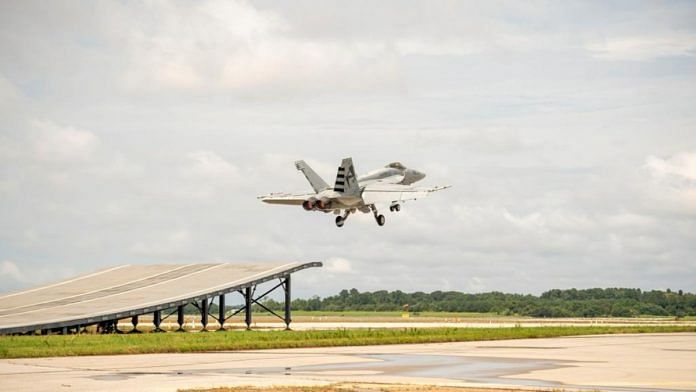New Delhi: American aviation giant Boeing Monday announced that its F/A-18 Super Hornet fighter has demonstrated compatibility with India’s aircraft carriers but remained sceptical about the Navy’s plan to combine its procurement tender for multi-role carrier-based combat jets along with that of the Indian Air Force’s for 114 planes.
Expected to face competition from the French Rafale aircraft for the Navy contract, Boeing has pitched the Super Hornets as the lynchpin for cooperation in naval aviation between the United States and India.
“The first successful and safe launch of the F/A-18 Super Hornet from a ski-jump begins the validation process to operate effectively from Indian Navy aircraft carriers,” Ankur Kanaglekar, head for India Fighters Sales at Boeing Defense, Space and Security, said Monday.
Briefing select journalists through video-conferencing about the demonstrations held at Naval Air Station Patuxent River in the US, Kanaglekar said they were always confident of meeting Indian requirements, but “we are even more confident now that we can fully meet the STOBAR (Short Take-off but Arrested Recovery) jump for Indian Navy”.
Carrier-based fighters mainly come in three categories — STOVL (short take-off and vertical landing), STOBAR and CATOBAR (catapult take-off but arrested recovery).
While American carriers use CATOBAR, the Indian carriers — INS Vikramaditya and the indigenous one under construction — employ STOBAR. Therefore, validation of the STOBAR capability by the Navy was a basic requirement.
Kanaglekar said the F/A-18 Block III Super Hornet will offer the Indian Navy value in the form of advanced war fighter technologies at a low acquisition cost and affordable cost-per-flight-hour because of its ease-of-maintainability design and durability.
The Indian Navy, he added, stands to benefit from the multi-billion dollar investments made towards new technologies in the Super Hornet by the US Navy and several international customers, including advanced network technology, longer range and low-drag with conformal fuel tanks, enhanced situational awareness with a new advanced cockpit system, and a 10,000+ hour life.
Pitching it as the lynchpin of naval cooperation between India and the US, the top Boeing official said the aircraft has the ability to interface with the American P-8I plane in use with the Indian Navy as a force multiplier and even future American systems.
“The commonality and interoperability between US and Indian Navy will be unmatched,” Kanaglekar said.
Also Read: Indian Navy gets 9th P-8I anti-submarine warfare aircraft ordered from US
‘Different requirements’
Asked about the Navy’s plan to combine its multi-role carrier-based combat jet procurement tender along with that of the IAF for 114 planes, Kanaglekar said he would refer the question to the Defence Ministry and the Navy.
“All I would say is that Indian Navy’s requirement and the Air Force’s requirements are very different,” he added, stating that the environment and mission are different between a carrier- and land-based operations.
“However, we are confident that MoD (Ministry of Defence) will take all that into account and will make the decision for the Indian armed forces while taking into account the cost of acquisition and timelines for these procurement,” Kanaglekar said.
Navy chief Admiral Karambir Singh had said earlier this month that they may pursue joint acquisition of fighters with the IAF.
“We have the MiG-29K operating from the Vikramaditya and will operate from the Indigenous Aircraft Carrier (IAC)-I. To replace them, we have taken up a case for the Multi-Role Carrier-Borne Fighters (MRCBF) which we are trying to do along with the IAF,” he said.
It was in 2017 that the Navy issued a Request For Information (RFI) to foreign players for 57 new fighters.
However, with the Defence Research and Development Organisation (DRDO) now working on a Twin-Engine Carrier-Based Deck Fighter (TEBDF), it is likely that the Navy could actually cut down its numbers for a foreign fighter from the 57 it was looking at earlier.
Asked if the the Boeing will offer India both Super Hornets and its twin-engine tactical fighter, the F-15EX, Kanaglekar said they will only take a decision once the final requirements of the IAF and the Navy come out.
“Boeing is very proud to bring complete spectrum of capability to the Indian armed forces,” he added.
Also Read: Navy could take minesweeper vessels & helicopters on lease, pushes for third aircraft carrier



